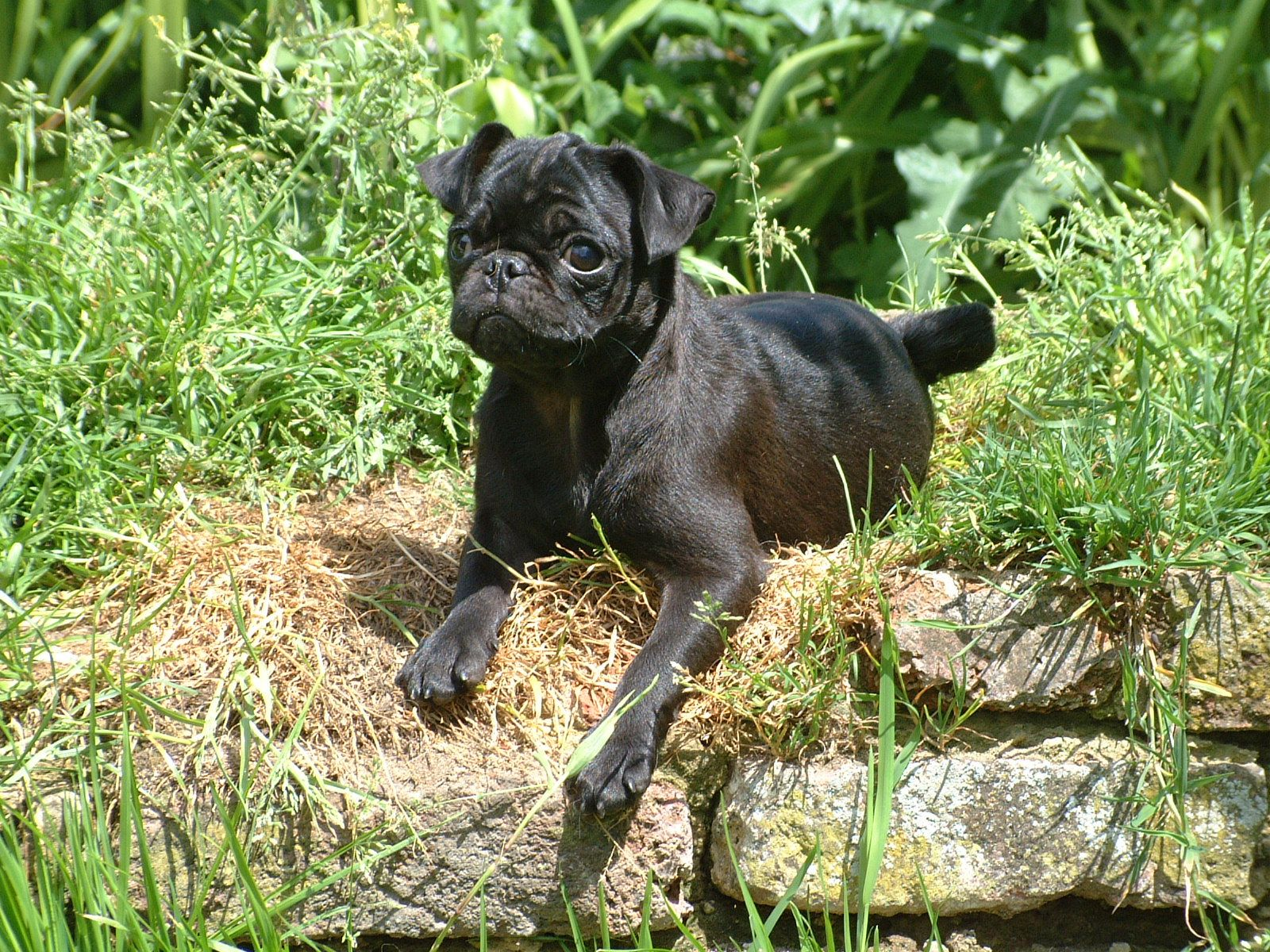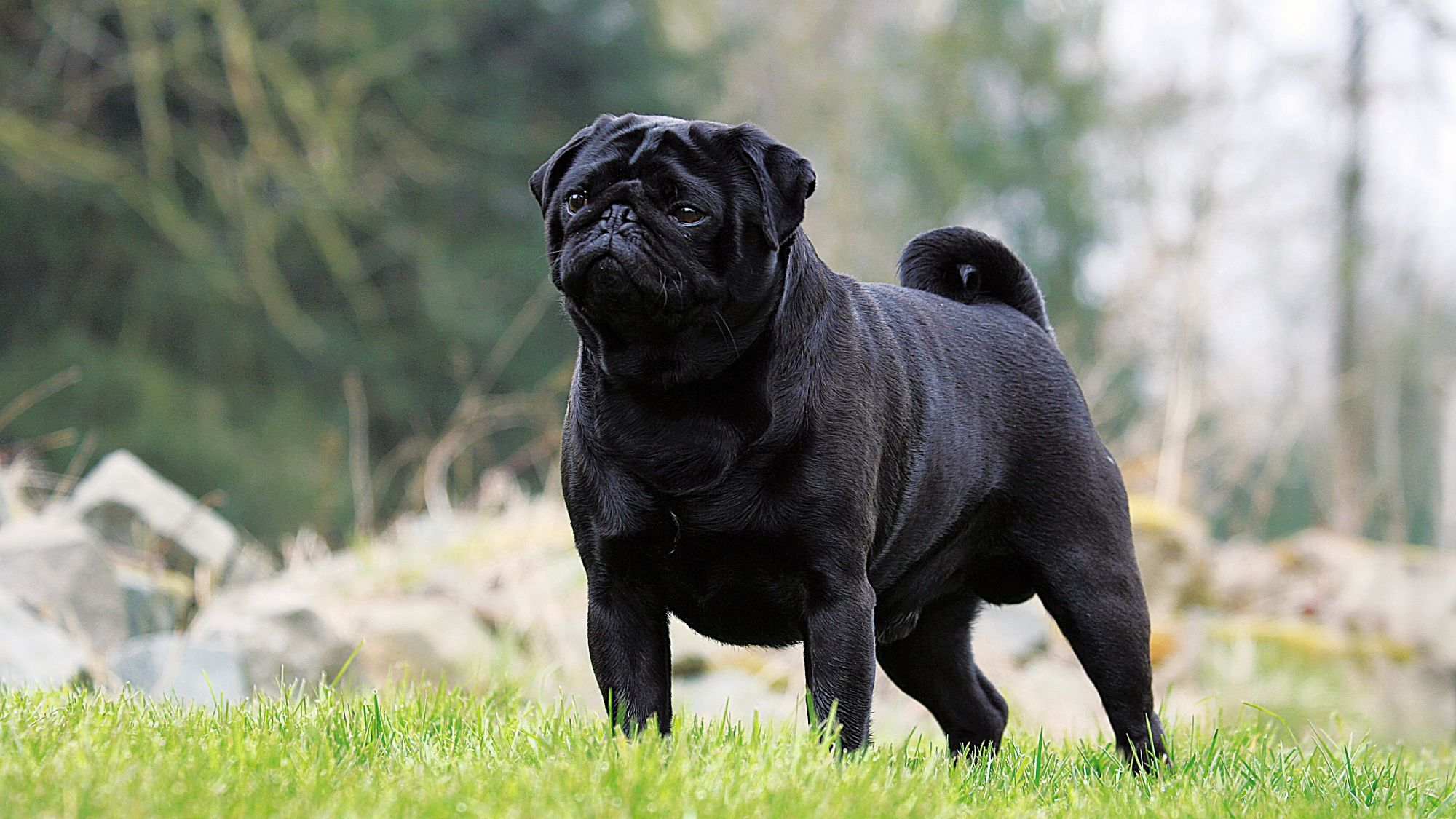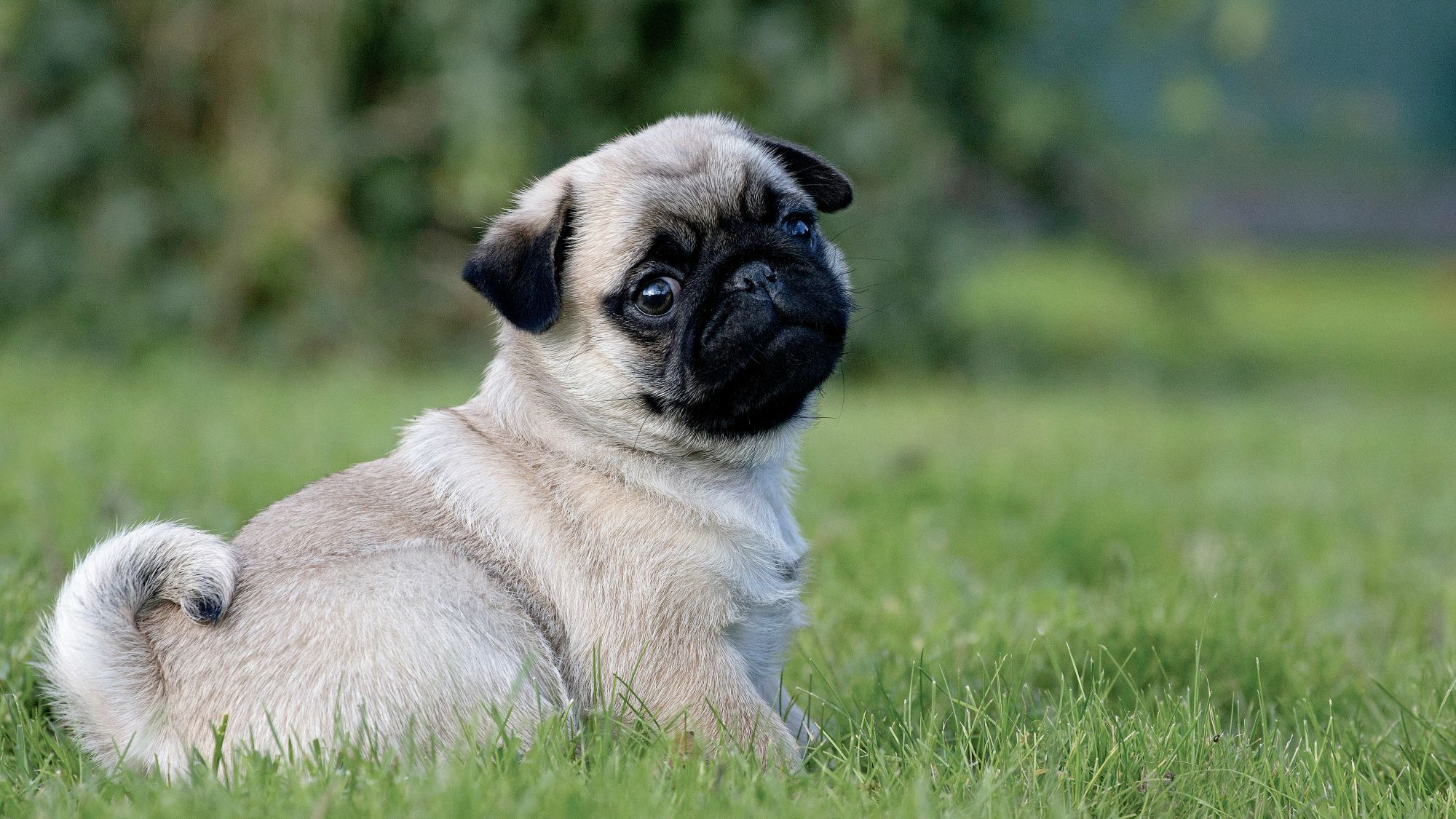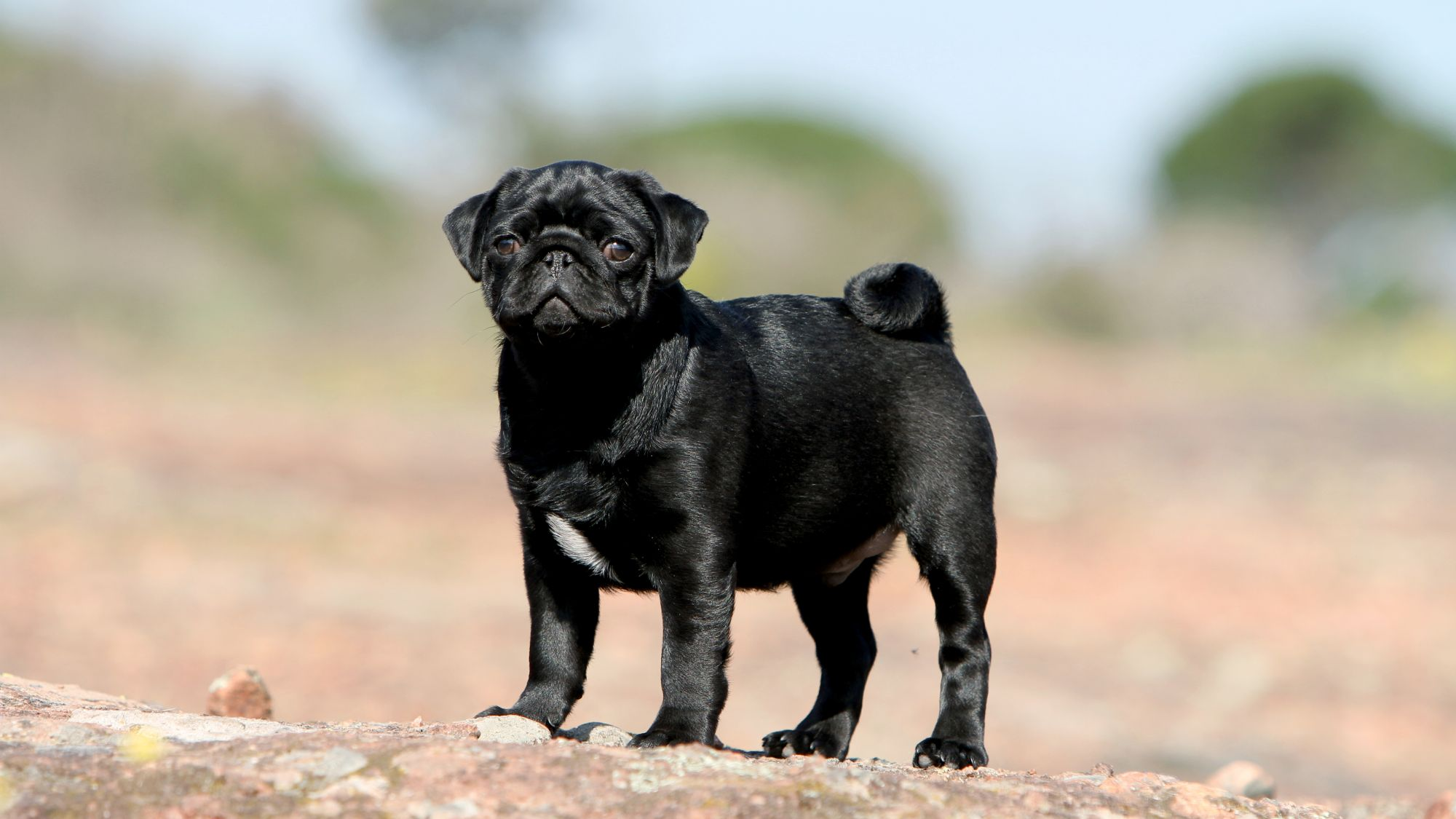Let's talk Pugs
A popular member of the toy group of breeds, the Pug is a barrel-shaped bundle of canine fun. With their unique appearance, they’re always the star of the show, and they have a sweet-natured, playful disposition too. Their coat is easy to maintain, they don’t require tons of exercise and they’re not a breed that barks very much either. The Pug even has its own Latin motto, “Multum in Parvo”, which translates as: “A lot in a little.”
Official name: Pug
Other names: Pug Dog, Chinese Pug
Origins: China
Drooling tendencies
1 out of 5Grooming needs
2 out of 5Shedding Level
4 out of 5Barking tendencies
1 out of 5Energy level*
1 out of 5Compatibility with other pets
4 out of 5Warm weather?
1 out of 5Cold weather?
2 out of 5Suited to apartment living
5 out of 5Can be left alone
1 out of 5Family pet?*
4 out of 5
| Male | Female |
|---|---|
| Height | Height |
| 26 - 33 cm | 25.5 - 26 cm |
| Weight | Weight |
| 6.3 - 8.1 kg | 6.3 - 8.1 kg |
| Life stages | |
|---|---|
| Puppy | Adult |
| 2 to 10 months | 10 months to 8 years |
| Mature | Senior |
| 8 to 12 years | 12 to 20 years |
| Baby | |
| Birth to 2 months | |
Drooling tendencies
1 out of 5Grooming needs
2 out of 5Shedding Level
4 out of 5Barking tendencies
1 out of 5Energy level*
1 out of 5Compatibility with other pets
4 out of 5Warm weather?
1 out of 5Cold weather?
2 out of 5Suited to apartment living
5 out of 5Can be left alone
1 out of 5Family pet?*
4 out of 5
| Male | Female |
|---|---|
| Height | Height |
| 26 - 33 cm | 25.5 - 26 cm |
| Weight | Weight |
| 6.3 - 8.1 kg | 6.3 - 8.1 kg |
| Life stages | |
|---|---|
| Puppy | Adult |
| 2 to 10 months | 10 months to 8 years |
| Mature | Senior |
| 8 to 12 years | 12 to 20 years |
| Baby | |
| Birth to 2 months | |

Get to know the Pug
All you need to know about the breed
Cute, quirky and characterful, the Pug looks almost like a real-life ‘Baby Yoda’. Very in-demand, especially with families, they are renowned for their even-tempered, docile disposition. Once trained they’re great with children and other pets – especially as they have a playful side to their personality – and Pugs are quite smart little dogs too.
They also have the advantage of being a fairly low-maintenance breed. Their short, smooth coat makes them easy to care for and they require only a moderate amount of exercise.
A fairly quiet breed, the Pug doesn’t tend to bark that much. A favorite of dog-lovers for a mere 2,000 years, the Pug was originally bred in China, where snub-nosed dogs have always been in vogue. Brought over to Europe in the 16th century, they have been a popular pet dog on both sides of the world ever since. A member of the toy group of dogs, the Pug is unique in being the only member to share their ancestry with the Mastiff. Notably, both breeds have the same wrinkly features in common.
Small but solid, Pugs have a soft, smooth coat that comes in a range of colors – from silver and apricot to fawn and black. They also have a particularly expressive face. Known for their barrel-shaped body, the silhouette is completed by their distinctive curled tail. One thing to bear in mind is that their squat stature and couch-potato tendencies can make Pugs prone to putting on weight. But no need to worry; as long as they have the right diet and enough exercise, it’s not hard to keep your Pug in shape.
On that note, with an average life expectancy of 12 to 15 years, the Pug has a pretty good lifespan, too. A popular fixture in film and television, the Pug dog breed often pops up on our screens. Perhaps most notably in the Men in Black franchise that features Frank – a fictional talking Pug. In the TV series Spin City, Carter’s pet Pug, Rags, frequently steals the show. And a Pug called Bess appears in The West Wing, too. Stars one and all!

Two facts about Pugs
1. Not to be sneezed at
If they get over-excited, Pugs are prone to what is known as ‘reverse sneezing’³, causing them to gasp and snort. However, this is not usually harmful, and massaging the throat and calming them with soothing words can help to shorten an episode.
2. The French connection
Joséphine Bonaparte, wife of Napoleon, was herself a fan of the Pug dog breed and had her own dog called ‘Fortune’. What's more, when she was imprisoned in Paris, she smuggled out messages by hiding them under her dog’s collar. For more facts on the history of the Pug, see below.
History of the breed
When the British returned home, they brought with them some of the dogs they had found there. The breed subsequently found fame in the US, as well, and the Pug was recognized by the American Kennel Club in 1885. More recently, the breed has continued to gain in popularity and the Pug is now among the most coveted of the toy varieties.
From head to tail
Physical characteristics of Pugs
1.Head
2.Muzzle
3.Body
4.Fur
5.Tail

Things to look out for
From specific breed traits to a general health overview, here are some interesting facts about your Pug
They can be prone to respiratory issues
The Pug is what is known as a ‘brachycephalic’ breed, which means they can be susceptible to breathing difficulties. This is due to the shape of their head, muzzle and throat. Other examples of this include the French and English Bulldogs, the Pekingese and the Boston Terrier. In the case of the Pug, their breathing passageways are particularly compact. This also means that Pugs don’t do well in hot weather, and can suffer from heatstroke, so their walks should be timed accordingly. As always with these things, prevention is better than cure, so it’s important to buy from a responsible breeder who will be aiming for the healthiest dogs possible.
Eye problems can be another area of concern
The large, globe-shaped eyes of the Pug are one of their best-loved features. But they can develop certain problems. Among these are cataracts, corneal ulcers and eyelid/eyelash disorders as well as a condition called pigmentary keratopathy that is common in brachycephalic dogs. As early detection can often help to head off more serious issues, it’s a good idea to check their eyes regularly for any warning signs. Your Pug’s weekly grooming sessions can be a good moment for this. Also, regular optical examinations can be booked in with your vet for long-term peace of mind¹.
It’s best to leave breeding to the professionals
One of the lesser-known issues that could affect your Pug – and only if they are a female – is a condition called ‘dystocia’. Essentially, this is a difficulty in giving birth, and it means that Pugs can often require a Caesarean to ensure the safe delivery of their puppies. As this can be dangerous for your dog, having your Pug spayed is highly recommended. In any event, it’s best to leave breeding to the professionals who know how to ensure the safety of both the mother and her puppies. Responsible breeders will also screen for various hereditary conditions and breed selectively to make sure their features don’t become too exaggerated².
Tailored nutrition for Pugs

When choosing food for a Pug, there are many factors to consider: their age, lifestyle, activity level, physiological condition and health, including potential sickness or sensitivities. Food provides energy to cover a dog’s vital functions, and a complete nutritional formula should contain an adjusted balance of nutrients to avoid any deficiency or excess in their diet, both of which could have adverse effects on the dog. The following recommendations are for healthy animals. If your dog has health problems, please consult your veterinarian, who may recommend an exclusive veterinary diet.
Immune System Support
As puppies grow, they will experience big changes and new discoveries. During this key period, the puppy's immune system develops gradually. Pug Puppy helps support your puppy's natural defenses with an exclusive complex of antioxidants including Vitamin E.
Healthy Skin
Coat condition is a reflection of the dog's state of health and overall well-being. Pug Puppy helps support the skin's role as a barrier with an exclusive complex of nutrients and helps maintain skin and coat health (EPA, DHA and vitamin A).
Digestive Health
Formulated with high quality protein (L.I.P.*) and prebiotics to support digestive health and a balanced intestinal flora, contributing to optimal stool quality. *Protein selected for its very high digestibility.
Exclusive Kibble: Special Brachycephalic Jaw
This exclusive kibble has been developed to be perfectly adapted to the jaw of the Pug puppy, making it easy to pick up and chew.

The main nutritional goals for adult Pugs are:
Healthy Skin
Nutrition plays an important role in maintaining healthy skin in the Pug. The exclusive formula of Pug Adult helps support the skin's role as a barrier with an exclusive complex of nutrients and helps maintain skin health (EPA and DHA).
Ideal Weight
Excess weight gain can affect the health of the Pug. An appropriately balanced food is therefore necessary for their health. This formula helps maintain the Pug's ideal weight.
Muscle Tone
This formula helps maintain the Pug's muscle tone with an appropriate protein content. Contains L-carnitine.

After 8 years old, Pugs start facing the first signs of aging. A formula enriched with antioxidants can help maintain their vitality and an adapted phosphorus content will support their renal system³. Aging is also accompanied by the modification of digestive capacities and particular nutritional requirements, so food for older Pugs should have the following characteristics:
Ideal Weight
Helps maintain ideal weight by meeting a small dog’s specific energy needs.
Vitality Support
Supports heart, kidney and brain health in first stage of aging.
Strong Bones
Helps maintain strong bones with precise blend of calcium and phosphorus.

Caring for your Pug
Grooming, training and exercise tips
This is a breed that likes nothing better than cozying up to their owners on the sofa. But as they also adore their food, it’s important that Pugs exercise every day. Up to an hour should do the trick, either by walking them or taking them on a trip to the dog park. They enjoy playing games in the garden, too.
One thing to remember is that Pugs are less suited to running, as this may cause them to hyperventilate. Also, in hot weather, it’s best to take them out early or late in the day to avoid the midday sun. As they generally can’t swim, water should be avoided as well⁵.
One of the many benefits of having a Pug is the minimum grooming required. Their short, smooth coats pretty much look after themselves. All they will need is a gentle weekly once-over with a medium-bristled brush or a grooming mitt. Pugs won’t even need bathing unless they’ve been rolling in any mud. Just one word of warning: Pugs can shed rather a lot during the shedding season so will need extra brushing to remove any dead hair. Nails should be kept short with regular clipping and ears and eyes checked for anything out of the ordinary. Lastly, frequent teeth-brushing is important, as are periodic dental check-ups⁴.
While it’s true that the Pug is the perfect companion animal, these little lapdogs can be a tiny bit stubborn at times – especially when it comes to house training. Pugs will benefit, therefore, from early learning at puppy-training classes. Once they get the hang of things, they are quite intelligent animals and learn quickly. They will also benefit from the early socialization that the classes bring. It’s always best to use reward-based training and positive reinforcement, as Pugs can be quite sensitive and thrive on encouragement and praise. Later, Pugs can go on to do well at activities such as obedience.
This is a breed that likes nothing better than cozying up to their owners on the sofa. But as they also adore their food, it’s important that Pugs exercise every day. Up to an hour should do the trick, either by walking them or taking them on a trip to the dog park. They enjoy playing games in the garden, too.
One thing to remember is that Pugs are less suited to running, as this may cause them to hyperventilate. Also, in hot weather, it’s best to take them out early or late in the day to avoid the midday sun. As they generally can’t swim, water should be avoided as well⁵.
One of the many benefits of having a Pug is the minimum grooming required. Their short, smooth coats pretty much look after themselves. All they will need is a gentle weekly once-over with a medium-bristled brush or a grooming mitt. Pugs won’t even need bathing unless they’ve been rolling in any mud. Just one word of warning: Pugs can shed rather a lot during the shedding season so will need extra brushing to remove any dead hair. Nails should be kept short with regular clipping and ears and eyes checked for anything out of the ordinary. Lastly, frequent teeth-brushing is important, as are periodic dental check-ups⁴.
While it’s true that the Pug is the perfect companion animal, these little lapdogs can be a tiny bit stubborn at times – especially when it comes to house training. Pugs will benefit, therefore, from early learning at puppy-training classes. Once they get the hang of things, they are quite intelligent animals and learn quickly. They will also benefit from the early socialization that the classes bring. It’s always best to use reward-based training and positive reinforcement, as Pugs can be quite sensitive and thrive on encouragement and praise. Later, Pugs can go on to do well at activities such as obedience.
7/7
All about Pugs
No, of all the different dog breeds you could choose, Pugs are probably one of the easiest. As well as their easy-going personalities, their short coats are super-easy to care for. Also, due to their small size and not being an especially high-energy breed, Pugs only require a moderate amount of exercise.
Yes, Pugs make an excellent choice for families as they are playful and affectionate. As with any dog, training is essential, with kids if possible. Pugs are considered to be an ideal dog for families.
Other breeds that might interest you
Read more on this topic
Like & share this page